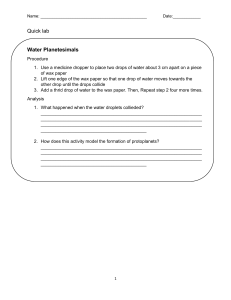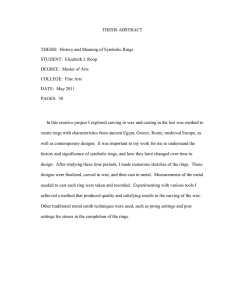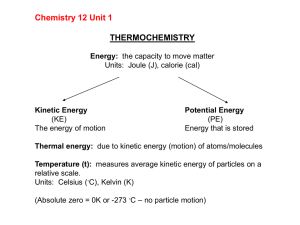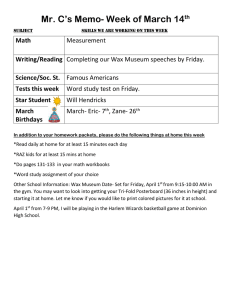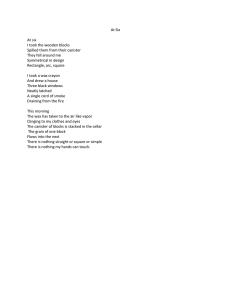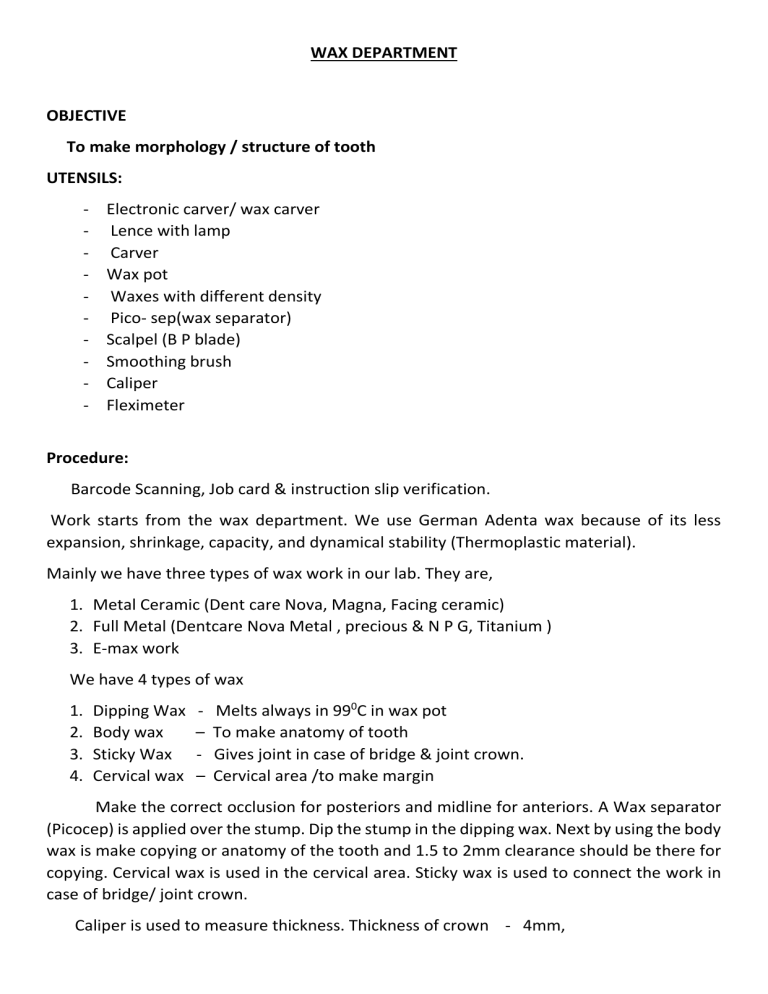
WAX DEPARTMENT OBJECTIVE To make morphology / structure of tooth UTENSILS: - Electronic carver/ wax carver Lence with lamp Carver Wax pot Waxes with different density Pico- sep(wax separator) Scalpel (B P blade) Smoothing brush Caliper Fleximeter Procedure: Barcode Scanning, Job card & instruction slip verification. Work starts from the wax department. We use German Adenta wax because of its less expansion, shrinkage, capacity, and dynamical stability (Thermoplastic material). Mainly we have three types of wax work in our lab. They are, 1. Metal Ceramic (Dent care Nova, Magna, Facing ceramic) 2. Full Metal (Dentcare Nova Metal , precious & N P G, Titanium ) 3. E-max work We have 4 types of wax 1. 2. 3. 4. Dipping Wax Body wax Sticky Wax Cervical wax – – Melts always in 990C in wax pot To make anatomy of tooth Gives joint in case of bridge & joint crown. Cervical area /to make margin Make the correct occlusion for posteriors and midline for anteriors. A Wax separator (Picocep) is applied over the stump. Dip the stump in the dipping wax. Next by using the body wax is make copying or anatomy of the tooth and 1.5 to 2mm clearance should be there for copying. Cervical wax is used in the cervical area. Sticky wax is used to connect the work in case of bridge/ joint crown. Caliper is used to measure thickness. Thickness of crown - 4mm, Bridge - .5mm. Scalpel & smoothening carver is used (electronic carver) to takeout the extra part or thickness. Wax works in our lab Full metal with full morphology, Acrylic facing, Inlay, Onlay, Post & Core, Space maintainer, Non Precious Gold Full metal, Titanium full metal, E-max works, Metal ceramic. Wax mock up White wax is used to make a full morphology. Wax trial to doctor for perfection in final work. E-max work Lithium disilicate pressable glass-ceramic material is used. Five types of work are i) Crown ii) Bridge iii) Inlay iv) Onlay v) Veneer Three methods are 1. Staining: Full anatomical work, no body build-up 2. Layering: Ingot frame + Ceramic body 3. Cut Back technique: Enamel apply on labio -Incisal tip area. Job details are to be entered and send to the next section INVESTING. EVALUATION 1. Which are the Different types of waxes 2. What are the Steps involved in the wax-up process. INVESTING Objective: Make the wax work for dewaxing and to convert as metallic form Tools Procedure: Barcode Scanning, Job card, instruction slip verification. Cast is checked under a microscope (Cropping frame) to check irregularities, folding in margins, rocking, etc. Three steps involved in investing are, i) Spruing ii) Base molding iii) Investing 1. Spruing Different sizes and shapes of sprues are available. Sprue is placed on work at 450 angles –.3mm thickness for crown and .4mm thickness for the bridge. For bridge and bigger works, big balloon suppliers are used. “ L ” shaped cooling sprue is used for pontic. 2. Base molding Weigh the crucible former (base). Mount the sprued work on base center 3 mm gap to be maintained with work & work. Between the ring and work 5mm. Weigh the total i.e., (base + work). Subtract the weight of base from the total weight. Total weight – base weight = Wax weight Wax weight x 8.3 (density) = Metal weight This is the weight of metal required for work. Work is inserted in a ring. 3. Investing (Refractory mound) Picocep is sprayed to avoid air bubbles. Vaseline is applied inside the ring and on-base as a separating medium. Heat-provided phosphate bonded Adentavest powder is mixed with Adenta tech liquid and distilled water in correct ratio 30-seconds hand mix + I minute vacuum mixing). This mixture is poured into the ring and sprue placed in the ring by placing on the vibrator. Setting time 30 minutes. Job details are to be entered and sent to Casting. Evaluation 1. Write any two features of investment material. CASTING Objective Tools Procedure: Barcode Scanning, Job card , Instruction slip verification. Casting is the process by which wax work is dewaxed and replaced by metal frame. Types of casting are: 1. 2. 3. 4. 5. Induction casting – Pressure casting Vacuum casting – Titanium casting – E-max Pressing – Centrifugal force Argon force Vacuum casting Argon force Pressing Force For Co Cr, Precious gold, and non-precious gold, the Ring is to be placed in a pre-heating furnace at 9000 C for an hour. In the meantime, wax is burnt off & space remains. Metal to be placed in the crucible such that the mouth of the crucible and ring are face to face for 2-3 minutes. So that metal gets melted & fill the empty space left by the wax. For Titanium, preheating time is 7.30 – 8 hours at 9000 C decreased to 4000 C & last one hour 4000 C. For E- max pressing, 1.15 hours is the pre-heating furnace duration at 8500 C. A small ring is chosen for smaller work and a big for bigger. Ingot to be placed and selected as per shade. Plunger to be dipped in separating medium and load on Ingot (pressing take place) here wax is replaced by wax. After cooling, the ring is broken ansandblastingng is done with aluminum oxide 1100 C. Work details are entered and passed to the next section. EVALUATION 1. Write any two features of a dental alloy. 2. Different types of casting machines. METAL FINISHING Objective Tools Procedure: Barcode Scanning, Job card, instruction slip verification. The metal finishing department provides a proper and finishing to the metal. Works from CAD-CAM and wax department after casting reach here. Two types of works are DMLS and Metal Ceramic. i) Insertion – Removal of metal extras, melt, and air bubbles with electric motor and bur. Removes sprue, high point, correction, and marginal level is checked. Insertion of metalwork on the stump and proper insertion is assured. Lipstick is applied to check the seat. Lipstick visible portions are trimmed and perfect seating and insertion are made. ii) Finishing – Metal ceramic and facing ceramic works come to this section. Doctors instruction and Job card to be read. Work type to be checked. Metal trial to be provided if asked. For full metal, a ceramic body is not required. For facing, a Ceramic body is required on the facial side. Thickness is to be measured with a caliper. Disc and mantle are used to soften and shape the work. Use carbide to smoothen in the same direction if it is to be sent for glazing. Metal thickness of Nova crown .3 mm and Bridge .4 mm. For MLS CAD-CAM; crown .4 mm, Bridge. 5 mm. Bite and high point to be checked with the articulator. Insertion is done after checking and correcting of marginal level. Duplicate model to be also checked. Full metal and facing ceramic is sent for Polishing and others to Opaque iii) Metal polishing – Full metal works – full anatomy is cleared, Glazed, and sent to final checking and dispatch. Read Job card and check whether the work is done as per the instructions. Check upper and lower occlusion, high point, contact, margin, etc. Insert and correct in case of an air bubble or melting mark. Highpoints and movements to be checked with Articulator. Check the morphology. Metal and facing ceramic work are polished mainly. The inner side of the work is to be sandblasted with sandblasting machine. Sprue to be sized, shaped, smoothened using disc without losing its morphology. Use carbide to glaze the work. Highpoint to be removed with highpoint bur. Draw groove with groove bur. Use brown wheel and blue wheel to polish the work. Check the work, use polishing soap and polishing brush to buff the working buffing motor. Use a steam cleaner and steam clean the work. If full metalwork, send it to final checking and to dispatch. Evaluation Differentiate between the full metal crown and PFM Dental alloys used in the dental lab for making core. OPAQUE Objective: Materials & Tools: Procedure: Both MLS and Nova works reach here the five main stages of work in opaque after checking metalwork. 1. Oxidation 2. Micro blasting 3. Apply to wash opaque 4. Apply first opaque 5. Apply second opaque Nova work will be sent to oxidation to remove impurities of metal at 1100 program (Aluminum Oxide). All works including Nova and DMLS are sent to micro blasting to gain bonding strength for work. Steam cleaning to be done with a steam cleaner. Artery forceps are used to hold micro-blasted and steam cleaned work to avoid air bubbles and dust. First coating (Wash) after steam cleaning 3C bond to be mixed with distilled water. Use brush and apply a thin layer and set 50 programs in the furnace. The second time is 20 minutes. The second opaque is given A1- D4 a total of 16 opaque shades are available. Shade to be verified in job card and shade tab (Ivoclar, 3D Master, and Vita shades are available). Check the work- facial or full ceramic. IPS shade + IPS liquid is mixed with the spatula on glass rode and a thin uniform shade is given so that the shade of stump is not visible. For facial, only buccal or labial side and tip to be shaded, for a full ceramicfull tooth. Uniform thickness is given to avoid are bubbles and blackening. Placed in a furnace in eleven programs, checked, and send to next section ceramic body. Evaluation What are the functions of opaque coating? CERAMIC BODY Objective Tools Procedure: Barcode Scanning, Job card, instruction slip verification i) ii) Body build-up: Works from Opaque & E-max reach here. Read the instruction slip, Job card. Steam clean work before & after correction. Check shade and use deep dentine, dentine, effect powder, enamel, and orange with body liquid and mix in glass slab. Work and powder should be wet. Apply deep dentine 1 mm ceramic brush in the cervical area. Give dentine for the body in the same size and shape as the original tooth. Orange is used for occlusal surfaces. Cut back body and apply effect powder and enamel from incisal tip to middle, mesial and distal. Keep work in firing tray and fire in a ceramic furnace. Ceramic insertion: Seating and marginal level are checked. Blue artifole paper is used to check proximal clearance. Excess portions are removed and perfect seating is assured. Evaluation List out powder materials for body build up. CERAMIC FINISHING Objective : Tools Procedure : Barcode Scanning, Job card, instruction slip verification Check the gender of patient and opposite is checked for shape. Proximal contact is checked with blue artifole paper and side is made convex with diamond bur. Caliper is used to measure thickness and bur is used to make the tooth identical to the adjacent and opposite. a) Anterior finishing Model to be checked and impurities to be removed. Check the Gender and mark the contact by drawing line and point angle. Aesthetics is given importance for anteriors. Mamalons, tubercles, contacts, anatomy, High point, bite, primary plane, mesial and distal anatomy are priority. Mesial should be straight and distal to be convex Lingual side should be ‘V’ shaped and separation is given with a pencil. Contacts to be rounded. Disc bur is used for grinding. Uniform thickness to be given. High point to be checked. Length of tooth is checked with a glass slab. Grooves are given with air router. Check rocking and to seat tooth on model and duplicate b) Posterior finishing Function and occlusion are the main concern on the posterior aspect. Seating, correction, high point, full anatomy and morphology, occlusion, bite, contact, movement, cusp, ridge, groove, fissure, Sulcus, etc. are to be taken care incorporated point angle and line angle to be drawn and shaped accordingly. Margin adaption, High point and seating to be checked both in model and duplicate. Evaluation What are the major steps involved in ceramic finishing? GLAZING AND STAINING Objective Tools and Materials: Procedure: Barcode Scanning, Job card, instruction slip verification Steam cleaned work is polished with stain liquid and then with shade. The shade on instruction slip is cross checked with given shade and polished with glazing paste and then shaded. Stain liquid also can be applied prior to shading. Furnace the work and shade to be matched. Apply the glazing paste and reapply the same shade. For pressable ceramic work. Work to be cleaned under running water and steam cleaned after glazing. The shades of the tooth are given by Value, Hue, and Chroma. These factors affect the depth and perfection of shade. 1. Value: White has more value than black. Value decreases from A1-A4 2. Chroma: Intensity of color. Intensity increases from A1-A4 3. Hue: Determines the color. A1-A4: Reddish, B1-B4: yellowish, C1-C4: grayish, D2-D4: red grayish. The depth of the shade depends 70% on value, 20% on chroma, and 10% on hue. When the value increases, chroma decreases. So increase value. EVALUATION 1.Why do we glaze a work before sending it? 2.Difference between shade tab and shade tab. FINAL CHECKING Objective: Tools: Duropolish, knife-edge, white wheel, rose wheel, blue wheel, blue artifol Procedure: Microblasting is done for the work in presence of Aluminum Oxide at 1100c to eliminate the green color attached to the material during staining. Steam cleaning to be done. Final checking includes through checking of various parameters such as…. Shade, sharpness, roughness, porosity, air bubble, black spot, glazing, metal polish, crack, sandblasting & cleaning, fitting, open margin, overextension, margin short, proximal contact, metal expose, rocking, stains, morphology, the height of contour, embrasure, size & shape, not within arch, function, canine guidance & all movements, occlusal high point, under occlusion, bulkiness in metal, collar, pontic type, opaque inside coping. Evaluation What are the steps involved in the final checking process.? FINAL QUALITY CHECKING Objective: Tools: Caliper, Articulator, Blue artifol paper Procedure: Quality of product is ensured here by our quality analyzing team. The major areas of concern here are Rocking in model and duplicate Margin shortage and adaptation Perfection in ceramic finishing Shade perfection/ Stain/ Glaze/ Translucency Proximal contact and seating Occlusion, under occlusion and high point Movements Sandblasting inside Opaque inside coping Articulator checking Evaluation Parameters used to check a work finally before dispatch. DISPATCH Objective: Tools: Procedure: The work is to be removed from the model, wrap in cotton, insert in polythene cover, place on the model and to be wrapped in air bubble paper, and to be kept in the box. Warranty cards and bills are inserted into the box. Address sticker and name including job number are pasted on the top of the box and packed tightly with a rubber band over it. Boxes are loaded into corresponding area boxes and passed over either to the logistics dept. for distribution or through courier services and respective executives collects the work and distribute to their clients. Evaluation List out the packaging materials and mention their importance.
